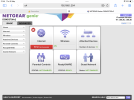Ah, I see what you meant now. Yes, my router has different MACs for 2.4 and 5 (I imagine it has another for the world facing connection too, but can't find it in the menus).Wifi base stations have MAC addresses. Often they're printed on a label underneath.
But all our devices that are using WiFi just have one for both frequencies.
On the hardwired side I haven't yet identified a device entry for the ethernet switch that serves all the video devices. (5-port Netgear box with one port back to the router and the other four to TV, etc.) I'd have thought that would have an ID, or are switches a special case?



 ?
?